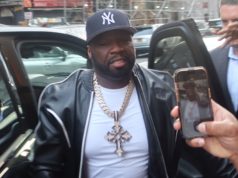All we can do is sit and wait while music executives dig up Leonard Cohen for a duet with Ed Sheeran
Objectively, the most iconic thing Justin Timberlake has ever done is shroud himself in denim. The year was 2001. Fashion was in crisis. Timberlake showed up to the American Music Awards with then-girlfriend Britney Spears who wore a matching evening gown of luscious, flowing denim. Seventeen years later, his music – background-ish and sometimes catchy – is entirely beside the point.
Then you have Prince. An artist so innovative and genre-defying that, in 1993, he changed his name to an unpronounceable symbol, while the world looked on and said, “Yeah, that seems about right.”
This week, at the Super Bowl, an event known (outside of the US at least) more for its gargantuan musical halftime show than for actual American football, the two artists “performed” together. Or, more accurately, Timberlake engaged in a fourteen minute-long robotic medley of his greatest solo hits, while Prince was unable to look on with Old Testament godlike fury, because (having died two years ago) he was a projection. While Timberlake covered Prince’s I Would Die 4 U, images of Prince loomed in the background, singing along. This, despite the fact that in life, not only did Prince not particularly like Timberlake (joking once, “For whoever is claiming they are bringing sexy back, sexy never left!”) but, in an interview with Guitar World in 1998, he also referred to the idea of jamming with a digitised version of a dead musician as “the most demonic thing imaginable”.
Timberlake’s “duet” with Prince wasn’t the first time a hologram of a dead artist has been used in a living one’s performance. In 2012 Dr Dre and Snoop Dogg shared the stage at Coachella with the long-dead Tupac. Even further back, in 2007, Celine Dion was slated for her digital duet with none other than Elvis, on American Idol. So although this trend is hardly new, it has at least something of “ deepfake porn ” – in which mostly female celebrities’ faces are digitally superimposed onto those of porn actresses – about it. Performing with a dead artist, although far less disturbing and potentially harmful, still involves two of the same key elements: digitisation and lack of consent. Many of Prince’s hardcore fans have stressed, although admittedly they have no way of knowing for sure, that The Artist would absolutely no way in hell have chosen to perform with Timberlake.
And if the abysmal reviews of Timberlake’s new album, Man of the Woods (because apparently he’s Father John Misty or something now) are anything to go by, then yeah, Prince would be pretty insulted. Man of the Woods, the tragic ending to a story about white, male, hetero mediocrity, could really not be less Prince-like. From it’s tit-achingly hetero dudebro title, to the absolute “WHAT EVEN IS THIS”-ness of the title track, it’s probably a mercy that the man who brought us Purple Rain isn’t alive to hear the state of the guy he just “performed” with in front of millions of people.
Meanwhile, all we can do is sit and wait while music executives dig up Leonard Cohen for a duet with Ed Sheeran. Or digitally forces David Bowie into a performance with Sam Smith. The options are terrifying and endless. And none of them involve creating anything new and/or exciting. Just a string of corny, rejected Black Mirror premises.
As Prince once said, “The music industry is a matrix that is counter to what is natural and right.”
Why do we need to search for Mary Shelley? This year is the bicentenary of the publication of Frankenstein, a first novel by a teenage girl that has become both a modern myth and a perennial A-level set book. Its author went on to write five more, much lengthier, novels, but, although academics have tried to wrest them from obscurity, Valperga, Falkner and the others remain inert. The electricity of Shelley’s first novel never returned to her.
The creation of Frankenstein has fascinated literary historians because it drew its energy from both the author’s youthful intellectual encounters and the tumult of her private life. The daughter of pioneering feminist Mary Wollstonecraft, who died shortly after giving birth to her, Mary Godwin, as she first was, grew up in the household of her father William Godwin, respected author of the once-famous work of anti-establishment, anti-religious philosophy, An Enquiry Concerning Political Justice. Here radicals, poets and scientists met and argued, and the brilliant young Mary drank it all in.
One such visitor was the young Percy Bysshe Shelley, already a father but estranged from his wife, Harriet, pregnant with their second child. Soon he was eloping to France with the 16-year-old Mary, the prelude to eight years of restive journeying between England and Europe, shadowed by tragedy (both Harriet Shelley and Mary’s half-sister, Fanny Imlay, committed suicide) and punctuated for Mary by pregnancies, miscarriages, and the deaths of three of her children. In the midst of this, at Villa Diodati on the shore of Lake Geneva, one thunderous June day in 1816, she competed with Shelley, Byron and Byron’s personal physician, John Polidori, to write a supernatural tale. The result was Frankenstein.
At the beginning of her new biography, the poet and critic Fiona Sampson bridles at the notion that Mary Shelley is a “one-book wonder”, yet she cannot escape just that notion. Her book is already four-fifths of the way through when Percy dies in 1822, drowned in Italy; his widow is not quite 25 years old. The remaining 28 years of her life, tenaciously devoted to earning a living and caring for her only surviving child, also called Percy, simply cannot command the same interest.
The story has often been told. So what can it mean to “search” for Mary Shelley again? Sampson’s book makes no claims to unearth new evidence or to read neglected manuscripts. Hers is a “search” of the imagination. She wants “to bring Mary closer to us, until she’s hugely enlarged in close-up”. She wants to ask about (the italics are hers) “ how it is for her ”. You will note the tense. In every sentence Sampson refuses the distance from which biography is usually written. The narrative is given in the present tense. As if we were in a novel, every event is a scene, taking place before us. It is all happening.
In the opening phases of the book this almost works. The lingering, agonising death of Mary’s mother from septicaemia caused by her physician, is terrible in its slow drama, haltingly recorded by Mary’s distraught father. Thereafter, however, the present-tense enactment is somehow presumptuous – Sampson’s way of insisting on every page that she is right there with her protagonist.
Being with Mary means being scornful of some of those to whom she was closest, especially Shelley himself. Potentially there is something bracing in Sampson’s impatience with his ideals, yet it leaves his allure an utter puzzle. He “resembles a type of highly gifted young man who receives a diagnosis of bipolar disorder but remains high-functioning because manifesting only on the manic end of the spectrum”. His poetry is mentioned only when it shows damning evidence of his romantic interest in other women. He is selfishly neglectful of his wife’s and children’s health.
Домой
United States
USA — Music It’s lucky Prince isn’t alive to see his Superbowl “duet” with Justin...






